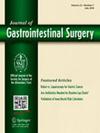Delta-integrated relaxation pressures as a new high-resolution manometry metric to predict the positive outcome of laparoscopic Heller-Dor in patients with achalasia
IF 2.2
3区 医学
Q3 GASTROENTEROLOGY & HEPATOLOGY
引用次数: 0
Abstract
Background
There is no consensus on the definition of failure after treatment in patients with achalasia. The Eckardt score is used to define clinical outcomes. However, objective metrics are lacking. This study aimed to identify whether any high-resolution manometry (HRM) parameters may be useful in predicting a positive outcome after laparoscopic Heller-Dor (LHD).
Methods
Patients who underwent LHD between 2012 and 2022 were enrolled. The patients were divided according to the outcome: the success group (SG) and the failure group (FG). In addition to the common HRM parameters, we measured the difference between pre- and postoperative integrated relaxation pressures (∆-IRPs). A receiver operating characteristic (ROC) curve analysis was performed to assess the accuracy of each HRM parameter.
Results
Of note, 336 patients (92.3%) were classified in the SG, and 28 patients (7.7%) were classified in the FG. No difference was found in terms of manometric types, symptom duration, and history of previous treatments. Preoperative lower esophageal sphincter (LES) pressure and IRP were higher in the SG than in the FG (41 vs 35 mm Hg [P =.03] and 33 vs 26 mm Hg [P =.002], respectively). The postoperative LES metrics were similar between the 2 groups, except for the ∆-IRP that was higher in the SG (23 mm Hg [IQR, 15–31]) than in the FG (14 mm Hg [IQR, 9–17]) (P =.0002). In the univariate analysis, age, LES preoperative pressure, IRP, and ∆-IRP were factors able to predict a positive clinical outcome. In the multivariate analysis, the ∆-IRP was the only parameter independently related to clinical success (odds ratio, 0.94; 5%–95% CI, 0.89–0.99). The ROC curve for the ∆-IRP showed an area under the curve of 0.71, with a threshold value set at 16.5 mm Hg (sensibility of 71% and specificity of 70%).
Conclusion
Our data showed that the ∆-IRP with a threshold of 16.5 mm Hg could represent a new objective tool for predicting the long-term positive outcome of LHD in patients with esophageal achalasia.
δ-irp作为一种新的高分辨率测压指标,可预测贲门失弛缓症患者腹腔镜heller-dor术的疗效。
对贲门失弛缓症患者治疗后失败的定义尚无共识。Eckardt评分(ES)用于定义临床结果,但缺乏客观指标。本研究的目的是确定是否有任何高分辨率测压(HRM)参数可能有助于预测腹腔镜Heller-Dor (LHD)后的阳性结果。方法:纳入2012-2022年间接受LHD的患者。根据治疗结果分为成功组(SG)和失败组(FG)。除了常见的HRM参数外,我们还测量了术前和术后综合松弛压力(∆- irp)之间的差异。应用ROC曲线分析来评估每个HRM参数的准确性。结果:336例患者(92.3%)分为SG组,28例(7.7%)分为FG组。两组在测压类型、症状持续时间和既往治疗史方面均无差异;术前食管下括约肌(LES)压力和IRP在SG组高于FG组(41 vs 35mmHg, p=0.03和33 vs 26mmHg, p=0.002)。两组术后LES指标相似,但SG组(23mmHg, IQR:15-31)的∆-IRP高于FG组(14mmHg, IQR:9-17, p=0.0002)。在单变量分析中,年龄、LES术前压力、IRP和∆-IRP是能够预测阳性临床结果的因素。在多变量分析中,∆-IRP是唯一与临床成功独立相关的参数(p)结论:我们的数据表明,阈值为16.5mmHg的∆-IRP可以作为预测食管贲门失弛缓症患者LHD长期阳性结果的一种新的客观工具。
本文章由计算机程序翻译,如有差异,请以英文原文为准。
求助全文
约1分钟内获得全文
求助全文
来源期刊
CiteScore
5.50
自引率
3.10%
发文量
319
审稿时长
2 months
期刊介绍:
The Journal of Gastrointestinal Surgery is a scholarly, peer-reviewed journal that updates the surgeon on the latest developments in gastrointestinal surgery. The journal includes original articles on surgery of the digestive tract; gastrointestinal images; "How I Do It" articles, subject reviews, book reports, editorial columns, the SSAT Presidential Address, articles by a guest orator, symposia, letters, results of conferences and more. This is the official publication of the Society for Surgery of the Alimentary Tract. The journal functions as an outstanding forum for continuing education in surgery and diseases of the gastrointestinal tract.

 求助内容:
求助内容: 应助结果提醒方式:
应助结果提醒方式:


